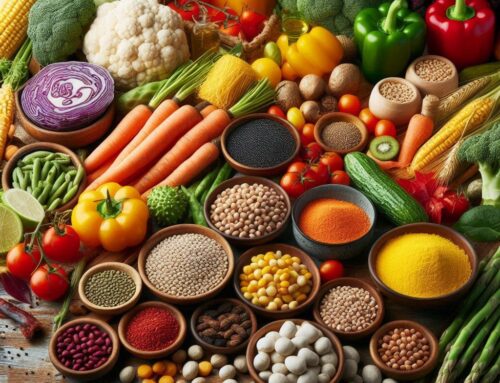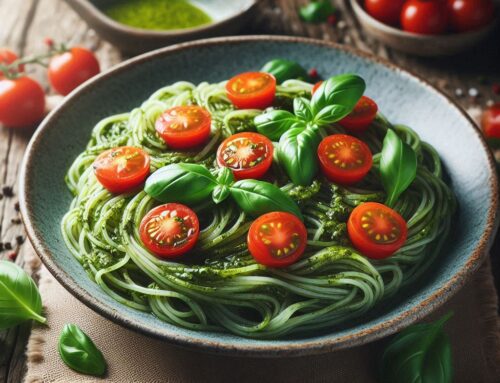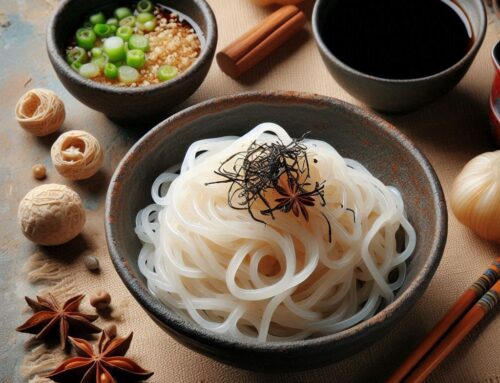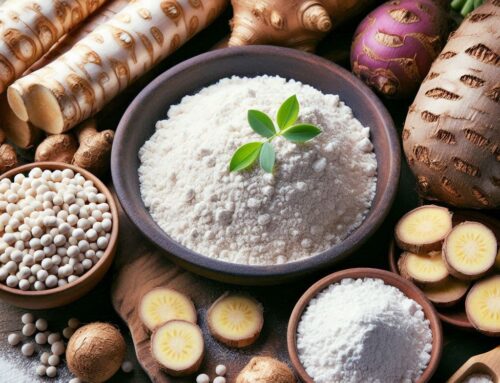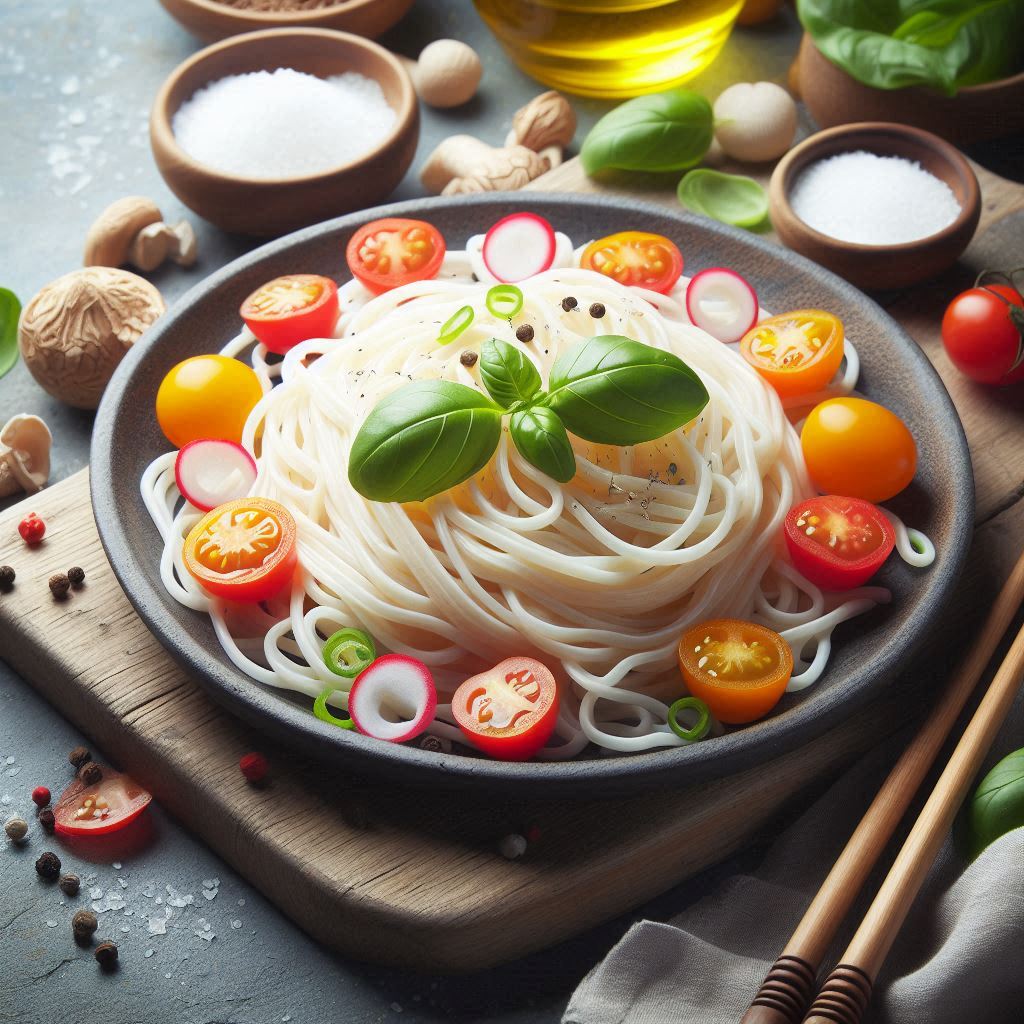
Introduction: What are Konjac Noodles and Why are They Called Skinny Pasta?
Konjac noodles, often referred to as “skinny pasta,” have gained significant attention in the world of health and wellness for their unique properties and benefits. These low-calorie noodles are derived from the konjac plant, a perennial plant native to parts of Asia. The konjac plant’s corm, or underground storage organ, is rich in glucomannan—a type of soluble fiber that gives these noodles their distinctive texture.
The appeal of konjac noodles lies primarily in their nutritional profile. Unlike traditional pasta, they contain minimal calories and carbohydrates, making them an attractive option for those looking to manage their weight or reduce carbohydrate intake without sacrificing the experience of enjoying a hearty pasta dish. This is why they are often dubbed “skinny pasta.”
Konjac noodles are versatile and can be used in a variety of dishes. Their neutral taste allows them to absorb flavors well, making them suitable for everything from stir-fries to soups. As people become more health-conscious and seek alternatives that align with dietary goals such as low-carb or gluten-free eating plans, konjac noodles offer an exciting solution that satisfies both nutritional needs and culinary desires.
Nutritional Profile of Konjac Noodles: A Low-Calorie Alternative
Konjac noodles, also known as shirataki noodles, have gained popularity as a low-calorie alternative to traditional pasta. These translucent noodles are made from the root of the konjac plant, which is native to Asia. One of the most appealing aspects of konjac noodles is their incredibly low calorie count; a typical serving contains only about 10 calories. This makes them an excellent choice for those looking to reduce their calorie intake without sacrificing volume or satisfaction in their meals.
In addition to being low in calories, konjac noodles are also considered a low carb pasta option. They contain minimal carbohydrates, making them suitable for people following keto or other low-carb diets. Furthermore, these noodles are rich in glucomannan fiber—a type of soluble fiber that can absorb water and expand in your stomach—helping you feel fuller for longer periods and potentially aiding in weight management.
The high fiber content of konjac noodles not only contributes to satiety but also offers several health benefits. Fiber is essential for maintaining healthy digestion and can help regulate blood sugar levels by slowing down the absorption of sugar into your bloodstream. Additionally, incorporating high fiber foods like konjac noodles into your diet may support heart health by helping to lower cholesterol levels.
Overall, the nutritional profile of konjac noodles makes them an attractive option for those seeking a healthier alternative to traditional pasta dishes while still enjoying satisfying meals with added health benefits.
Health Benefits of Incorporating Konjac Noodles into Your Diet
Konjac noodles, often referred to as “skinny pasta,” are gaining popularity for their impressive health benefits and versatility in various diets. One of the most notable advantages is their potential role in weight loss. These noodles are incredibly low in calories and carbohydrates, making them an ideal choice for those looking to shed a few pounds without sacrificing meal satisfaction. The glucomannan fiber found in konjac noodles expands in your stomach, promoting a feeling of fullness that can help reduce overall calorie intake.
Beyond aiding weight loss, konjac noodles offer significant digestive health benefits. The soluble fiber they contain acts as a prebiotic, nourishing the beneficial bacteria in your gut and supporting a healthy digestive system. This can lead to improved bowel regularity and reduced symptoms of constipation.
Moreover, konjac noodles may play a role in blood sugar control. The glucomannan fiber slows down the absorption of sugar into the bloodstream, which helps manage blood sugar levels more effectively after meals. This makes them an excellent dietary addition for those managing diabetes or looking to maintain stable energy levels throughout the day.
Incorporating konjac noodles into your diet not only supports weight management but also contributes to better digestive health and improved blood sugar regulation, making them a nutritious choice for anyone seeking healthier eating habits.
Culinary Uses: How to Cook and Enjoy Konjac Noodles in Your Meals
Konjac noodles, often referred to as “skinny pasta,” have become a popular choice for those looking to enjoy a guilt-free meal without compromising on flavor. These noodles are made from the konjac plant, known for being low in calories and high in fiber, making them an excellent addition to a healthy diet. Here are some cooking tips and recipe ideas to help you incorporate konjac noodles into your meals.
How to Prepare Konjac Noodles
Before diving into recipes with konjac noodles, it’s essential to know how to prepare them properly. Start by rinsing the noodles under cold water for about 2-3 minutes. This step helps remove any residual odor from the packaging liquid. Once rinsed, you can either boil or pan-fry the noodles depending on your recipe choice. Boiling them for 1-2 minutes will soften their texture slightly, while pan-frying can add a bit of crispiness.
Cooking Tips for Skinny Pasta
- Pair with Bold Flavors: Konjac noodles have a mild taste that absorbs flavors well, so don’t hesitate to use bold sauces or seasonings like soy sauce, garlic, ginger, or chili paste.
- Add Vegetables: Enhance your dish by adding colorful vegetables such as bell peppers, broccoli, or spinach. This not only boosts nutritional value but also adds texture and vibrancy.
- Include Protein: For a complete meal, include protein sources like grilled chicken, shrimp, tofu, or edamame alongside your konjac noodle dishes.
Recipes with Konjac Noodles
- Stir-Fried Konjac Noodles: Sauté your favorite vegetables and protein in sesame oil until cooked through. Add prepared konjac noodles along with soy sauce and a dash of rice vinegar for tanginess.
- Konjac Noodle Salad: Combine chilled konjac noodles with julienned carrots and cucumbers; toss them in a dressing made of lime juice, fish sauce (or soy sauce), and chopped cilantro for an Asian-inspired salad.
- Creamy Alfredo Konjac Pasta: For comfort food lovers craving something creamy yet light—prepare an Alfredo sauce using almond milk or cashew cream mixed with garlic powder and nutritional yeast; toss it over boiled konjac noodles before serving hot!
By following these preparation tips and experimenting with different recipes using skinny pasta alternatives like konjak noodle options—you’ll be able not only enjoy delicious meals but also maintain healthier eating habits effortlessly!
Konjac vs. Traditional Pasta: Comparing Taste and Texture
When it comes to pasta, many are exploring gluten-free alternatives that cater to dietary needs and preferences. Konjac noodles, made from the root of the konjac plant, have emerged as a popular option for those seeking a low-calorie and gluten-free alternative. But how do they stack up against traditional pasta in terms of taste and texture?
The texture of konjac noodles is notably different from that of regular pasta. Traditional pasta is known for its firm yet tender bite, offering a satisfying chewiness that pairs well with various sauces. In contrast, konjac noodles have a more gelatinous consistency due to their high water content and soluble fiber called glucomannan. This unique konjac noodle texture comparison reveals that while they may lack the familiar al dente quality, they can still provide an enjoyable eating experience when prepared correctly.
Taste-wise, there is also a distinct difference between skinny konjac noodles and regular pasta. Traditional wheat-based pasta has a neutral flavor that readily absorbs the taste of accompanying ingredients, making it versatile for numerous recipes. Konjac noodles have little to no flavor on their own but readily take on the flavors of whatever they’re cooked with. This characteristic makes them an excellent canvas for rich sauces or robust seasonings.
For those seeking gluten-free alternatives or looking to reduce carbohydrate intake without sacrificing their love for pasta dishes, konjac noodles offer an intriguing option worth trying. While they might not replicate every aspect of traditional pasta perfectly, they bring their own unique qualities to the table—literally—that can be equally satisfying in different culinary contexts.
Purchasing and Storing Tips for Konjac Noodles
When it comes to incorporating konjac noodles, also known as skinny pasta, into your diet, knowing where to purchase them and how to store them properly can enhance your culinary experience. These low-calorie noodles are gaining popularity for their health benefits and versatility in recipes.
Where to Buy Skinny Pasta:
Konjac noodles can be found in various places, from health food stores to major supermarkets. They are often located in the gluten-free or international foods section. For those who prefer shopping online, numerous retailers offer a wide selection of konjac products that can be delivered straight to your door. Be sure to check the product descriptions for any additional ingredients if you have specific dietary preferences or restrictions.
Storage Tips for Konjac Products:
Proper storage is crucial for maintaining the quality and safety of konjac noodles. Unopened packages should be stored in a cool, dry place away from direct sunlight. Once opened, it’s best to transfer any unused portions into an airtight container and refrigerate them promptly. This helps preserve their texture and flavor while preventing spoilage.
Shelf Life of Konjac Noodles:
The shelf life of konjac noodles varies depending on whether they are dry or packed in liquid. Typically, unopened packages have a long shelf life due to their stable nature; however, once opened, they should be consumed within a few days when refrigerated. Always check the expiration date on the package and follow any specific storage instructions provided by the manufacturer.
By understanding these purchasing and storing tips for konjac products, you can enjoy this healthy alternative with peace of mind while ensuring its freshness and taste remain intact until you’re ready to use it in your favorite dishes.



